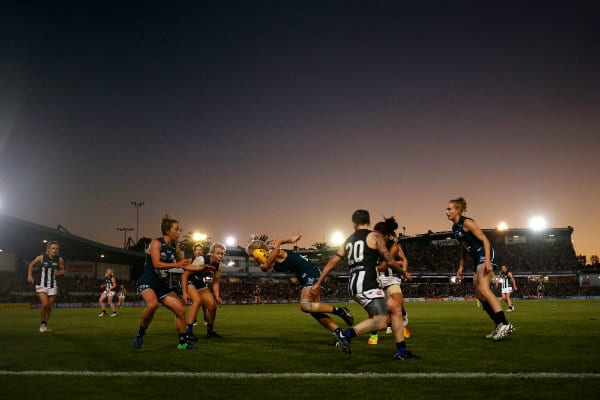Ikon Park wasn’t big enough.
Officials were expecting a little over 10,000 attendees but more than 25,000 people flocked to the historic match.
The AFL CEO Gillon McLachlan went outside to personally address the frustrated crowds who missed out on a seat inside.
It was a major disappointment for the fans but a massive win for women’s sport and the women on the field.
The women’s competition success was discussed at a Melbourne event hosted by Women In Media Victoria last week about the women transforming Australian sport.
“We’ve all heard [sporting bodies] trot out the line about ‘we want to be the sport of choice for women’ – well now they’re having to do something about it,” Angela Pippos said. “I think this is the tipping point in women’s sport.”
Broadcaster with Fox Footy, Kelli Underway, said the competition has proved to male executives that women’s sport can succeed but said sponsorship is critical.
“(Players) want to be the best footballers they can without worrying about paying the rent next week,” Underway said.
Almost all of the 145 women participating in the inaugural NAB AFL Women’s competition are – in effect – paying to play.
It contrasts starkly with the relative financial freedom their male peers enjoy.
The average professional male AFL player earns $300,000 a year which frees up time and money for hobbies, investments and a 24/7 commitment to their clubs and game.
They are all luxuries few women players can afford.
At present 16 marquee women players are being paid $27,000, some are earning $12,000, while most are taking home $8,500 for the eight-week competition and five-month training season. The women are responsible for paying for their own health insurance and income insurance, both of which are covered by the AFL for men.
But the fact they are being paid at all is still a thrill for the players and fans who have long dreamed of an elite professional competition for women.
For medical doctor Tiarna Ernst, playing for the Western Bulldogs and working as a trainee obstetrician/gynaecologist at Monash Health is a major undertaking. She is using a combination of annual leave and special leave to make it work this season and concedes she will lose out financially.
Codie Briggs, a baker and pastry chef by trade, has had to drop her work hours to play for the GWS Giants.
“I get up at 4.30am in the morning, start work at 5.30. It’s a very physically demanding job. I’m lifting 25kg bags of flour and sugar. I’m on my feet continuously. Then to have maybe a four-hour break in between to go to football training,” Briggs told Fox Sports.
For Kate Sheehan playing for Collingwood is a long-held dream but $8,500 isn’t enough to pay her bills. So, like many of her teammates and competitors, the mum-of-one is combining her stint as a professional athlete with a day job.
Shelley Scott milks cows on her family’s dairy farm, Richelle Cranston is a landscaper in Marshall, Alicia Eva works part-time assisting counsellors in a drug and alcohol treatment clinic. Aliesha Newman deliver mails, Emma Grant is a school teacher and Darcy Vesciois a graphic designer. The Bulldogs captain Katie Brennan has her own business which gives her flexibility.
“Hearing the stories of some of the girls who are travelling 2½ hours to get here plus waking up at 6am and working until 5pm every day, it’s massive,” Kate Brennan said. “I’m quite fortunate that I don’t have to do that, but for some of these girls it’s a massive barrier and essentially it prevents them from playing the best footy they can.”
The issue of pay has virtually been the only thorn in the side for the AFLW. The discrepancy in pay between men and women in AFL is vast and has been subject to considerable criticism.
It is emblematic of the 50% pay gap that persists across the board in sport.
Claire Braund, the coauthor of Women on Board’s Gender Balance in Global Sport Report 2016, says the success of women’s cricket and AFL will challenge one of the popular justifications for the difference in what men and women sportspeople earn.
“People will always argue that more people want to watch men’s sport and advertise during men’s sport but they haven’t had anything else to watch,” Braund says. “Traditionally men’s sport is all that’s been broadcast so there’s been no choice.”
That is finally beginning to change. Last year’s exhibition AFLW match drew the largest overall television audience for any footy match for the year, outside finals.
Channel 7 and Channel 10 have invested heavily in broadcasting women’s cricket and AFL in peak times – in the same quality as the men’s games – and the ratings indicate the investment will pay off.
Bruand is optimistic that money will follow.
“The popularity and quality of the women’s game combined with the fact that advertisers are increasingly looking to appeal to a broad audience that includes females, means we might find there are quite a lot of companies very happy to advertise in women’s AFL and women’s sport in general.”
If that’s the case, the critical thing will be how that money trickles down to the players.
Almost all of the female athletes involved in the AFLW are hopeful the financial upside for them personally will grow with the game. The early signs suggest their optimism is well-founded.


